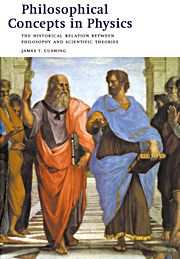 Philosophical Concepts in Physics
Philosophical Concepts in Physics Published online by Cambridge University Press: 05 June 2012
The theory of relativity is essentially the culmination of classical physics. Although revisions in our concepts of space and time are necessitated by both the special and general theories of relativity, the notion of causality, in which a cause precedes its effect, remains intact in the relativistic formulations of electrodynamics and mechanics and of gravitation. An upper limit is set on the speed of bodies, and of the propagation of energy, and physical quantities are often defined operationally, but once we adjust ourselves to these new rules, our representations of physical processes proceed pretty much as they did in classical physics. On the other hand, quantum theory seems to require a much more profound philosophical revision of our thought patterns. Even the viability of the usual meaning of a causal connection between one event and another is there called into question.
SOME HISTORICAL BACKGROUND
We begin with a brief and highly selective review of the experimental and theoretical problems that formed the conceptual backdrop to the emergence of quantum theory. We focus attention first on an important phenomenon – blackbody radiation – that was instrumental for the formulation of quantum mechanics. A blackbody is defined as a surface that absorbs all of the electromagnetic radiation that falls onto it. It is picturesquely so named since any light incident on such a body would be absorbed, making it appear black (at least at typical temperatures in our environment). A blackbody also emits radiation.
To save this book to your Kindle, first ensure no-reply@cambridge.org is added to your Approved Personal Document E-mail List under your Personal Document Settings on the Manage Your Content and Devices page of your Amazon account. Then enter the ‘name’ part of your Kindle email address below. Find out more about saving to your Kindle.
Note you can select to save to either the @free.kindle.com or @kindle.com variations. ‘@free.kindle.com’ emails are free but can only be saved to your device when it is connected to wi-fi. ‘@kindle.com’ emails can be delivered even when you are not connected to wi-fi, but note that service fees apply.
Find out more about the Kindle Personal Document Service.
To save content items to your account, please confirm that you agree to abide by our usage policies. If this is the first time you use this feature, you will be asked to authorise Cambridge Core to connect with your account. Find out more about saving content to Dropbox.
To save content items to your account, please confirm that you agree to abide by our usage policies. If this is the first time you use this feature, you will be asked to authorise Cambridge Core to connect with your account. Find out more about saving content to Google Drive.